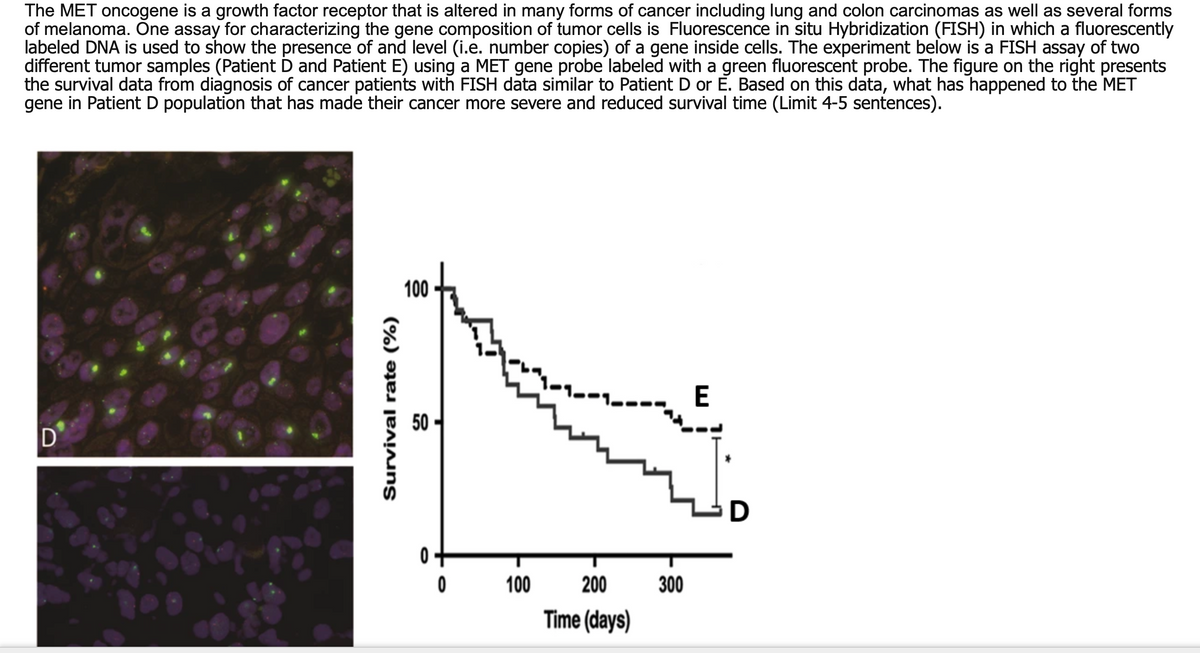The MET oncogene is a growth factor receptor that is altered in many forms of cancer including lung and colon carcinomas as well as several forms of melanoma. One assay for characterizing the gene composition of tumor cells is Fluorescence in situ Hybridization (FISH) in which a fluorescently labeled DNA is used to show the presence of and level (i.e. number copies) of a gene inside cells. The experiment below is a FISH assay of two different tumor samples (Patient D and Patient E) using a MET gene probe labeled with a green fluorescent probe. The figure on the right presents the survival data from diagnosis of cancer patients with FISH data similar to Patient D or E. Based on this data, what has happened to the MET gene in Patient D population that has made their cancer more severe and reduced survival time (Limit 4-5 sentences). D Survival rate (%) 2 100 0 0 100 200 Time (days) 300 E
The MET oncogene is a growth factor receptor that is altered in many forms of cancer including lung and colon carcinomas as well as several forms of melanoma. One assay for characterizing the gene composition of tumor cells is Fluorescence in situ Hybridization (FISH) in which a fluorescently labeled DNA is used to show the presence of and level (i.e. number copies) of a gene inside cells. The experiment below is a FISH assay of two different tumor samples (Patient D and Patient E) using a MET gene probe labeled with a green fluorescent probe. The figure on the right presents the survival data from diagnosis of cancer patients with FISH data similar to Patient D or E. Based on this data, what has happened to the MET gene in Patient D population that has made their cancer more severe and reduced survival time (Limit 4-5 sentences). D Survival rate (%) 2 100 0 0 100 200 Time (days) 300 E
Biology: The Dynamic Science (MindTap Course List)
4th Edition
ISBN:9781305389892
Author:Peter J. Russell, Paul E. Hertz, Beverly McMillan
Publisher:Peter J. Russell, Paul E. Hertz, Beverly McMillan
Chapter16: Regulation Of Gene Expression
Section: Chapter Questions
Problem 4ITD
Related questions
Question

Transcribed Image Text:The MET oncogene is a growth factor receptor that is altered in many forms of cancer including lung and colon carcinomas as well as several forms
of melanoma. One assay for characterizing the gene composition of tumor cells is Fluorescence in situ Hybridization (FISH) in which a fluorescently
labeled DNA is used to show the presence of and level (i.e. number copies) of a gene inside cells. The experiment below is a FISH assay of two
different tumor samples (Patient D and Patient E) using a MET gene probe labeled with a green fluorescent probe. The figure on the right presents
the survival data from diagnosis of cancer patients with FISH data similar to Patient D or E. Based on this data, what has happened to the MET
gene in Patient D population that has made their cancer more severe and reduced survival time (Limit 4-5 sentences).
D
Survival rate (%)
100
0
0
100
200
Time (days)
300
E
Expert Solution
This question has been solved!
Explore an expertly crafted, step-by-step solution for a thorough understanding of key concepts.
Step by step
Solved in 2 steps

Knowledge Booster
Learn more about
Need a deep-dive on the concept behind this application? Look no further. Learn more about this topic, biology and related others by exploring similar questions and additional content below.Recommended textbooks for you

Biology: The Dynamic Science (MindTap Course List)
Biology
ISBN:
9781305389892
Author:
Peter J. Russell, Paul E. Hertz, Beverly McMillan
Publisher:
Cengage Learning

Biology Today and Tomorrow without Physiology (Mi…
Biology
ISBN:
9781305117396
Author:
Cecie Starr, Christine Evers, Lisa Starr
Publisher:
Cengage Learning

Human Heredity: Principles and Issues (MindTap Co…
Biology
ISBN:
9781305251052
Author:
Michael Cummings
Publisher:
Cengage Learning

Biology: The Dynamic Science (MindTap Course List)
Biology
ISBN:
9781305389892
Author:
Peter J. Russell, Paul E. Hertz, Beverly McMillan
Publisher:
Cengage Learning

Biology Today and Tomorrow without Physiology (Mi…
Biology
ISBN:
9781305117396
Author:
Cecie Starr, Christine Evers, Lisa Starr
Publisher:
Cengage Learning

Human Heredity: Principles and Issues (MindTap Co…
Biology
ISBN:
9781305251052
Author:
Michael Cummings
Publisher:
Cengage Learning